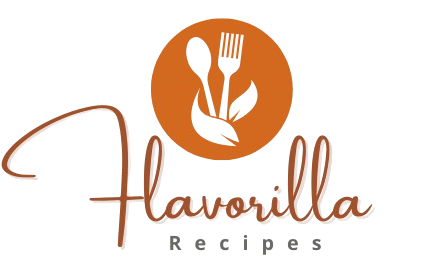The **German Pancake recipe**, often referred to stateside as a Dutch Baby, is a delightful culinary trick. It looks impressive—with its dramatically puffed, golden-brown edges—but is one of the easiest, most rewarding breakfasts you can make. It requires just a few basic ingredients, minimal prep time, and a hot oven to transform a thin, simple batter into a show-stopping centerpiece.
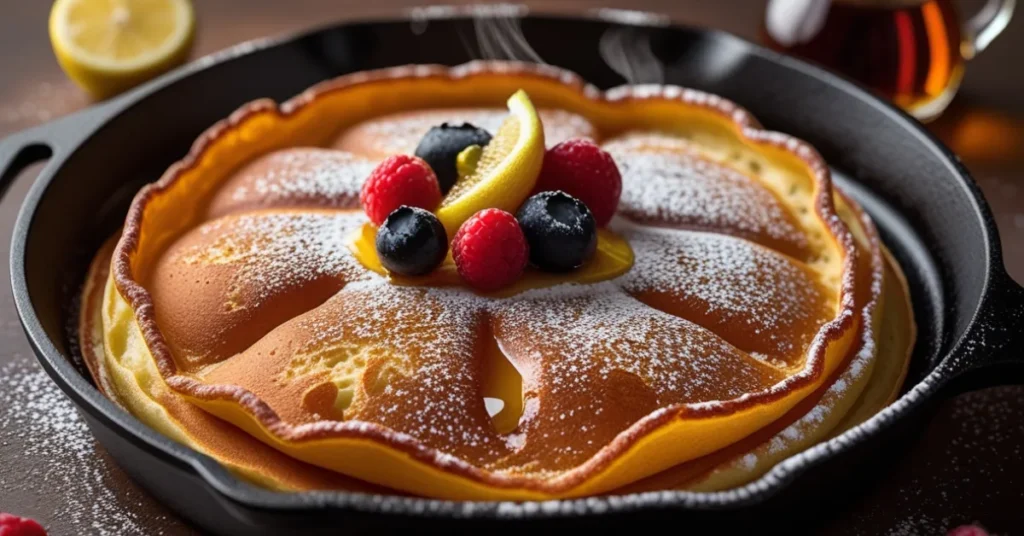
Unlike traditional stovetop pancakes, this baked delicacy contains no chemical leaveners. Its incredible rise is solely due to the steam generated by the high proportion of eggs hitting a pre-heated, extremely hot pan. This rapid reaction creates a contrast in texture: a crispy, buttery perimeter and a soft, tender, and slightly custardy center, unlike anything you’ll get from a griddle. This complete guide will walk you through the non-negotiable steps—from ingredient temperature to preheating the pan—to guarantee a perfect, massive puff every single time.
Mastering this classic **German pancake recipe** is a quick way to elevate your weekend brunch game, proving that the most spectacular dishes are often the simplest to execute.
- The Science Behind the Spectacular Puff in the German Pancake Recipe
- Essential Ingredients for the Best German Pancake
- Step-by-Step Instructions: Mastering the Classic German Pancake
- Troubleshooting: Why Didn’t My German Pancake Puff?
- Sweet and Savory Variations for Your German Pancake
- The Fun History: Why is it Called a Dutch Baby?
- Expert Tips to Perfect Your German Pancake
- FAQ: Essential Questions About the German Pancake Recipe (Dutch Baby)
- Conclusion: A New Favorite Comfort Food in Your Kitchen
The Science Behind the Spectacular Puff in the German Pancake Recipe
While the ingredient list for the **German pancake recipe** is short, the method relies heavily on physics. Understanding the role of heat and the composition of the batter is the key to achieving that signature, towering rise that makes a Dutch Baby so memorable.
The Critical Role of Heat and Steam
- **High Temperature:** The oven must be set to a high temperature, typically $425^\circ\text{F}$. This is necessary to immediately create steam when the batter is poured.
- **Preheated Pan:** The cast iron skillet or metal pan must be placed in the oven while it preheats. When the batter is poured into the hot, sizzling butter, the edges of the batter rapidly cook and set. This creates the rigid structure that traps the steam and forces the pancake to dramatically inflate upwards.
- **No Leavening Agents:** Since the recipe uses no baking powder or soda, the high moisture content of the eggs quickly turns to steam, which is the sole source of leavening. This is what creates those beautiful, airy edges.
Temperature Matters: Room Temperature Ingredients
This is arguably the most crucial tip for maximizing the rise. Using **room temperature eggs and milk** ensures that the batter doesn’t cool down the ultra-hot pan when poured. Cold ingredients would temper the heat, delaying steam production and resulting in a flatter, denser pancake. To quickly warm ingredients, let them sit out for 30 minutes, or place eggs in warm tap water for 5 minutes.
Essential Ingredients for the Best German Pancake
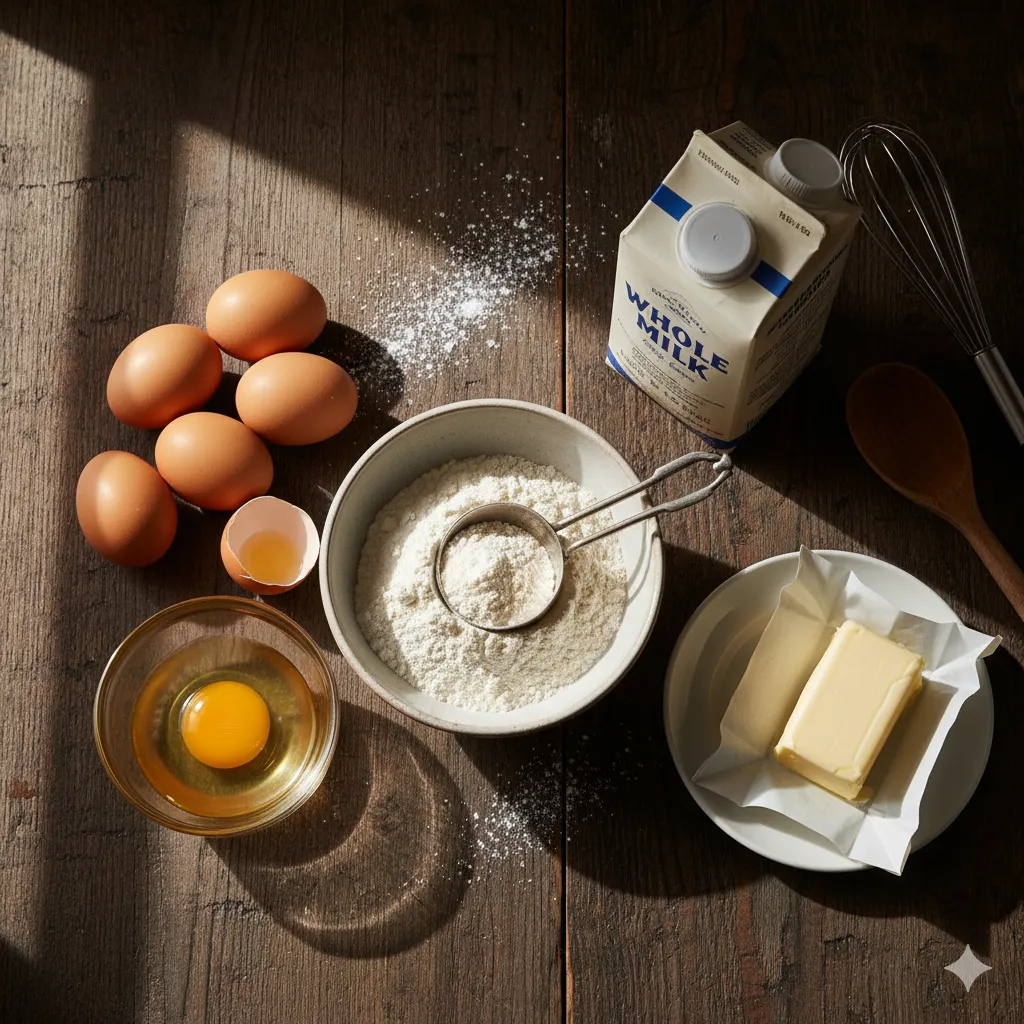
Simplicity is the hallmark of the **German pancake recipe**. Only a few high-quality pantry staples are needed for success.
Pancake Base Ingredients:
- **Eggs:** Six large eggs are necessary for both structure and the steam needed for the puff. They must be at room temperature.
- **Milk:** Use whole milk or $2\%$ milk. The fat content contributes to a richer, more tender, custard-like center.
- **Flour:** All-purpose flour is perfect. Make sure to level the flour when measuring to avoid a heavy batter.
- **Vanilla and Salt:** A teaspoon of vanilla extract and a pinch of salt enhance the overall flavor, balancing the richness of the butter and eggs.
Equipment Note: The Right Pan Size
For the best, most dramatic puff using the quantities in this **German pancake recipe**, a **10-inch cast iron skillet** or a **9×13-inch metal baking dish** is ideal. A pan that is too large (like a 12-inch skillet) will cause the batter to spread too thin, resulting in a flatter pancake with less vertical rise. A cast iron pan is the preferred choice, as its superior heat retention is crucial for the cooking process.
Step-by-Step Instructions: Mastering the Classic German Pancake
Follow these steps closely, focusing on preheating, to guarantee that picture-perfect, puffed result.
- Preheat the Oven and Pan: Place 6 tablespoons of butter (cut into pieces) in a 10-inch cast iron skillet. Place the skillet in the oven and **preheat the oven to 425°F ($220^\circ\text{C}$)**. The butter will melt and sizzle, and the pan will get screaming hot while the oven comes up to temperature—this is the most important step for the signature puff.
- Prepare the Smooth Batter: In a blender, combine the room-temperature eggs, milk, flour, vanilla extract, and salt. Blend on medium speed for 30–60 seconds until the batter is completely smooth and frothy, with no visible lumps. The batter should be thin, similar to heavy cream. *Tip:* Allow the batter to rest for 10-15 minutes after blending; this improves texture.
- Pour and Bake Immediately: Once the oven is fully preheated and the butter is melted and sizzling, **carefully** remove the hot pan. Swirl the pan to ensure the butter coats the sides. **Immediately** pour the smooth pancake batter into the center of the pan, directly over the hot butter. Do not swirl or stir the batter once it is in the pan.
- Bake to Golden Perfection: **Immediately** return the skillet to the hot oven. Bake for **20–25 minutes**. **Do not open the oven door** during this time. The **German pancake recipe** is done when the edges are dramatically puffed, golden brown, and the center is set. The pancake will begin to deflate the moment it is removed from the oven; this is normal.
- Serve with Classic Toppings: Remove the pancake, dust generously with confectioners’ (powdered) sugar, and serve immediately. The traditional topping is a squeeze of fresh lemon juice, which cuts the richness beautifully, along with maple syrup and fresh berries.
Troubleshooting: Why Didn’t My German Pancake Puff?
The “flop” is the most common issue with a **German pancake recipe**. It’s almost always a fixable temperature or timing problem. If your pancake comes out flat, review these crucial steps for your next attempt:
- **Cold Ingredients:** This is the #1 reason for failure. Cold eggs and milk shock the hot pan and inhibit steam. **Fix:** Use room temperature ingredients.
- **Oven Temperature Too Low:** The pancake requires high, aggressive heat ($425^\circ\text{F}$). **Fix:** Verify your oven temperature with a thermometer; many home ovens run cool.
- **Pan Was Not Hot Enough:** The butter must be melted and sizzling when the batter hits it. **Fix:** Wait until the oven is fully preheated and the butter is bubbling before pouring the batter.
- **Opening the Oven Door:** Losing the accumulated heat and steam during baking will cause the pancake to collapse prematurely. **Fix:** Do not open the oven door until the minimum cook time (20 minutes) has passed.
Sweet and Savory Variations for Your German Pancake
The simple, eggy base of this **German pancake recipe** makes it an excellent vehicle for both sweet and savory flavors, easily transitioning from breakfast to dinner.
Gourmet Sweet Toppings:
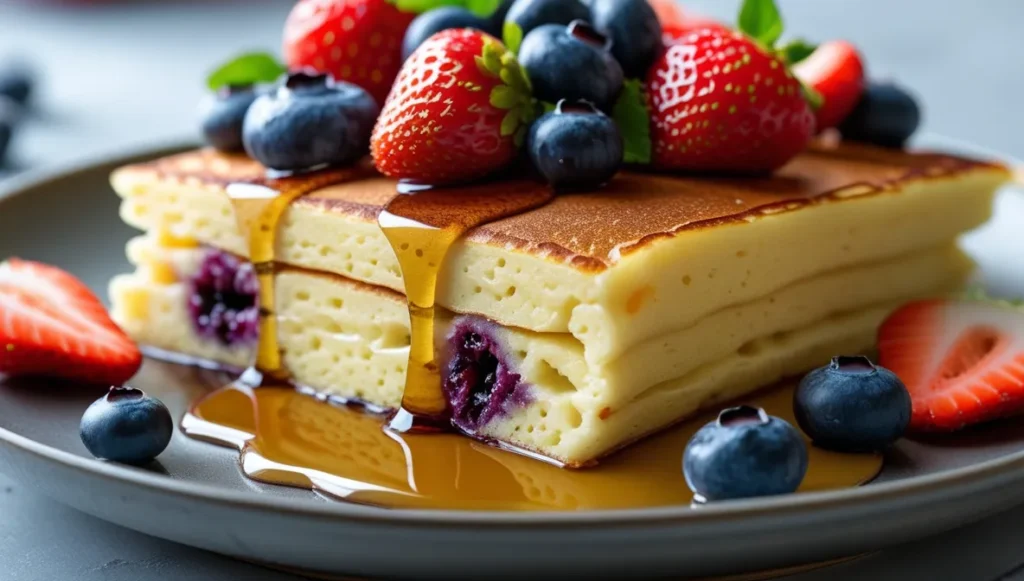
- **Apple Cinnamon:** Sauté 1-2 sliced apples (like Granny Smith) in 2 tablespoons of butter, $1/4$ cup of brown sugar, and $1$ teaspoon of cinnamon. Spread this mixture over the bottom of the pan *before* pouring in the batter, then bake as directed.
- **Peaches and Cream:** After baking, fill the deflated center with sliced fresh peaches (or canned/frozen, thawed) and a dollop of fresh whipped cream.
- **Zesty Brightness:** Add a pinch of freshly grated lemon zest to the batter for a brighter flavor that beautifully complements the lemon juice topping.
Savory German Pancake Twists:
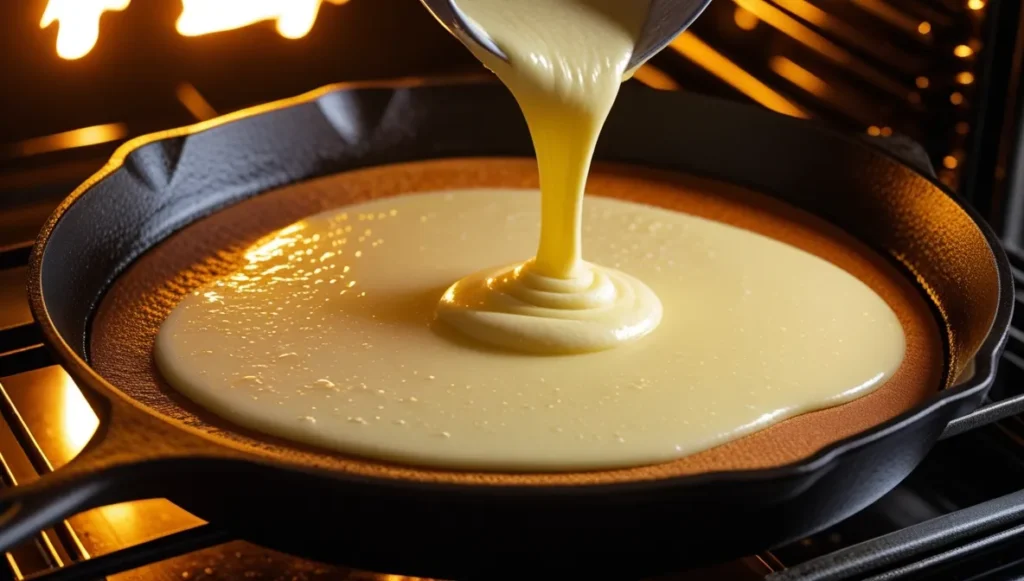
Turn this delicious breakfast into a unique Lunch or Dinner by adding savory elements.
- **Ham and Swiss:** Before pouring the batter, scatter thinly sliced ham and grated Swiss or Gruyère cheese over the melted butter. Bake as directed. Serve topped with fresh chives.
- **Bacon and Cheddar:** Sprinkle cooked, crumbled bacon pieces and sharp cheddar cheese over the hot butter before adding the batter. The salty bacon provides a great counterpoint to the eggy base.
- **Mushroom and Herb:** Sauté mushrooms and shallots with fresh thyme. Add them to the hot butter before the batter, and sprinkle with a small amount of Parmesan cheese.
The Fun History: Why is it Called a Dutch Baby?
The **German pancake recipe** has a confusing name in English. Despite being called a Dutch Baby, the dish is an American creation derived from the German *Pfannkuchen* (a pan-fried pancake, similar to a crêpe). The popular Americanized, baked version originated at Manca’s Cafe, a family-run diner in Seattle, Washington, in the early 1900s.
The cafe owner’s daughter is credited with coining the name. She likely mispronounced the German word for German, which is “Deutsch,” calling it “Dutch.” The “Baby” part of the name simply referred to the smaller, individual portions the restaurant served. Manca’s Cafe even trademarked the name “Dutch Babies” in 1942. So, while its roots are German, the name is pure American diner history. For more on the history of culinary terms, a great resource can be found at the **Oxford Companion to Food**.
Expert Tips to Perfect Your German Pancake
Beyond the basics, these tips will ensure your **German pancake recipe** is always light, crisp, and flawlessly puffy:
- **Check Your Oven’s Heat:** If you consistently struggle with the rise, your oven might not be hitting the target temperature. A separate oven thermometer is a cheap but effective tool to guarantee that $425^\circ\text{F}$ shock is delivered.
- **Blend Don’t Whisk:** While hand-whisking is possible, a blender or food processor makes a superior batter. It fully hydrates the flour and incorporates tiny air bubbles for a lighter texture and a smoother rise, without over-developing the gluten.
- **Adjust for Altitude:** If you live at a high altitude, you may need to increase the liquid slightly (add 1 tablespoon of milk) and reduce the flour by a small amount (1 tablespoon) to compensate for the lower boiling point of water, which affects steam production.
- **Serving Temperature:** The **German pancake recipe** must be served immediately! It begins deflating rapidly—sometimes within 60 seconds of leaving the oven. Have your toppings and powdered sugar ready to go.
The preparation for this delicious breakfast is quick, classifying it as a fantastic **Quick Recipes** option for any day of the week.
For a beautiful, fragrant **German pancake recipe**, consider adding a quarter teaspoon of ground nutmeg along with the salt and vanilla extract. Nutmeg is a classic addition that pairs perfectly with the egg-rich batter, especially when served with a hint of lemon.
Another crucial detail for maximizing flavor is to use high-quality butter. Since the butter is the fat the entire pancake cooks in, its quality shines through. Using a European-style butter with a higher fat content (often labeled as $82\%$ or more) will result in a richer, nuttier flavor and a crisper texture on the edges.
Do not be tempted to add sugar to the batter itself. The lack of sugar in the batter is intentional in the traditional **German pancake recipe**. Sugar can inhibit the gluten structure from properly expanding under the high heat, leading to a less dramatic rise. All the necessary sweetness should come from your toppings—powdered sugar, fruit, and syrup. This also allows the savory variations to work seamlessly without having to adjust the base recipe.
If you have a large family or are hosting brunch, consider making individual **German pancake recipe** servings. You can use large muffin tins, small 6-inch cast iron skillets, or even large, oven-safe coffee mugs. Divide the batter equally, reduce the baking time to 12-16 minutes, and ensure the individual pans are preheated with butter inside for the best puff. This can be much more efficient than trying to cook a massive pancake that takes longer to bake through.
Remember to keep your oven rack low enough to accommodate the puff! Since the **German pancake recipe** can rise dramatically, often doubling its height, ensure there are no racks directly above the skillet to prevent the top from burning or scraping the heating element. It is better to have the rack slightly lower than center, which also helps concentrate the heat towards the base of the pan for maximum crispiness.
A final note on texture: if you find your pancake deflates too quickly or the center is too thin, you might be using too much milk relative to the flour. For a denser, more custard-like center, you can try reducing the milk by 2 tablespoons next time. Conversely, if the center is too thick, add 1-2 extra tablespoons of milk to the batter. This small adjustment can tailor the **German pancake recipe** to your exact textural preference, whether you prefer the light, eggy center or a richer, thicker custard interior.
For a beautiful color, try to find a quality, pure vanilla extract. Some cheaper extracts can leave a slightly bitter aftertaste when baked at such high temperatures. The pure vanilla adds an incredible aroma as the pancake bakes, further enhancing the comfort food experience. Pair this simple, elegant dish with a refreshing glass of juice or a great cup of coffee for the perfect start to your day.
When serving the **German pancake recipe**, make sure to use a sharp knife to cut it into wedges. Serving it straight from the cast iron skillet adds a rustic, charming element to the presentation, making the simple dish feel sophisticated and inviting. It is a fantastic alternative to traditional pancakes or waffles, offering a unique texture that is both light and filling.
If you’re looking for another deeply comforting breakfast that can also feed a crowd, consider our rich and savory options in the Breakfast category. For a simple weeknight meal, our Italian Penicillin Soup is a fantastic choice that contrasts the light sweetness of this pancake with robust, savory flavors.
FAQ: Essential Questions About the German Pancake Recipe (Dutch Baby)
Is a German pancake the same thing as a Dutch baby?
Yes, they are essentially the same dish. The **German pancake recipe** is the more accurate, descriptive term, as the dish originated from the German *Pfannkuchen* tradition. The name “Dutch Baby” is the popular American nickname and trademarked name that originated at Manca’s Cafe in Seattle, derived from a mispronunciation of the German word “*Deutsch*” (German).
Can I make the German pancake batter ahead of time?
Yes, you can prepare the **German pancake recipe** batter, cover it, and store it in the refrigerator for up to 24 hours. However, for the best and most dramatic puff, you must allow the batter to sit at **room temperature** for at least 30 minutes before baking to ensure all ingredients are warm enough to create maximum steam when they hit the hot pan.
What is the best pan to use for this recipe?
The **best pan** is a heavy, oven-safe material that retains heat exceptionally well, such as a **10-inch cast iron skillet**. A 9×13 metal baking dish also works well for a flatter, wider pancake, but avoid glass dishes, as they do not conduct heat as efficiently and can inhibit the puff.
Why do you need so many eggs in the German pancake recipe?
The high egg content (typically 6 large eggs) is crucial because the eggs are the sole leavening agent. They provide the necessary protein to build the structure and, most importantly, generate a large amount of steam when heated quickly. This steam is what causes the pancake to puff dramatically without any baking powder or soda.
How do I serve the German pancake?
The pancake must be served immediately! The traditional way is to dust it generously with powdered sugar and squeeze fresh lemon juice over the entire dish. The acidity of the lemon perfectly cuts the richness of the butter and eggs. Other popular toppings include maple syrup, fresh berries, jams, and whipped cream.
Conclusion: A New Favorite Comfort Food in Your Kitchen
The **German pancake recipe** is a culinary gem that proves elegance and ease can coexist in the kitchen. By following the simple, yet crucial, rules of temperature—using room-temperature ingredients and an extremely hot, buttered pan—you will consistently achieve the impressive, towering puff that defines the Dutch Baby.
This recipe delivers a satisfyingly rich, yet incredibly easy-to-make dish that is bound to become a mainstay in your **Breakfast** or **Quick Recipes** repertoire. Whether you enjoy the classic topping of lemon and powdered sugar or experiment with a hearty savory variation, this dish is a delightful and unique alternative to standard morning fare.
Skip the complicated brunch plans. Grab your cast iron, follow these steps, and treat yourself and your family to the spectacle of the perfect homemade **German pancake recipe**. It is a delicious, buttery marvel, ready in minutes, and guaranteed to impress.
